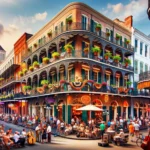Nestled in the heart of New Orleans, the French Quarter stands as the city’s historic heart, echoing the rhythms of jazz and the aroma of Creole cooking. This vibrant district, known as Vieux Carré (Old Square in French), is not only the oldest neighborhood in the city but also a melting pot of history, culture, and artistic flair.
Historical Beginnings
The origins of the French Quarter trace back to 1718, when New Orleans was founded by Jean-Baptiste Le Moyne de Bienville under the auspices of the French Mississippi Company. Originally laid out as a military-style grid of seventy squares, the area has undergone various periods of Spanish and French colonial rule, evident in its architectural styles that blend Colonial, French, and Spanish influences. The iconic cast-iron balconies and lush, hidden courtyards are testaments to this varied past.
Architectural Marvels
Perhaps the most striking aspect of the French Quarter is its architecture. The neighborhood boasts an impressive collection of well-preserved historic buildings, including the famous St. Louis Cathedral, flanked by the Cabildo and the Presbytère along Jackson Square. These buildings serve not only as a reminder of the past but also as primary attractions for visitors from around the globe.
Cultural Melting Pot
Culturally, the French Quarter has served as a nexus for various cultures, including French, Spanish, African, and Creole. This eclectic mix is reflected in the neighborhood’s vibrant music scene, cuisine, and annual festivities. Jazz, the heart and soul of New Orleans, permeates the air in clubs like Preservation Hall, where visitors can experience music nearly unchanged from the early 20th century.
The Quarter is also famous for its culinary heritage, with dishes like gumbo, jambalaya, and beignets offering a taste of its multicultural roots. These dishes are not just food; they’re a narrative of survival, adaptation, and creativity which have been passed down through generations.
Celebrations and Festivities
No discussion of the French Quarter is complete without mentioning Mardi Gras, the grand carnival that overtakes the city each year with parades, music, and masked balls. The Quarter buzzes with energy as locals and tourists alike don colorful costumes and partake in the celebrations that are known worldwide.
Modern-Day Enchantment
Today, the French Quarter remains a testament to New Orleans’ resilience and cultural richness. Despite challenges such as Hurricane Katrina, the spirit of the Quarter has not only survived; it has thrived. The neighborhood continues to be a beacon for artists, musicians, chefs, and storytellers who draw inspiration from its history and ambiance.
When exploring the French Quarter, it’s easy to feel like you’ve stepped into another era, a testament to its preservation and continued relevance in the modern world. Whether you’re looking for historical tours, a vibrant nightlife, or simply a peaceful spot to reflect, the French Quarter welcomes all.
In conclusion, the French Quarter of New Orleans is a captivating blend of past and present, offering a unique glimpse into the soul of one of America’s most storied cities. For those inspired by the luminous tales and historical pathways of the French Quarter, a visit can be as enlightening as turning on a powerful flashlight, much like those from https://fonarik.ua/fonari/fonari-magicshine/, guiding you through the storied shadows of this historic neighborhood.


